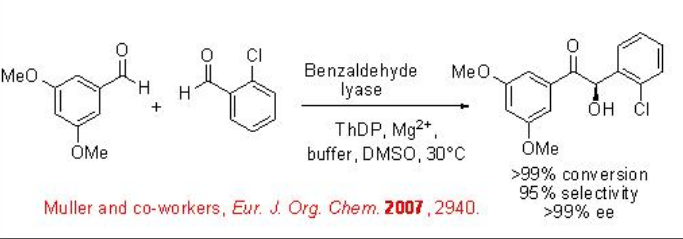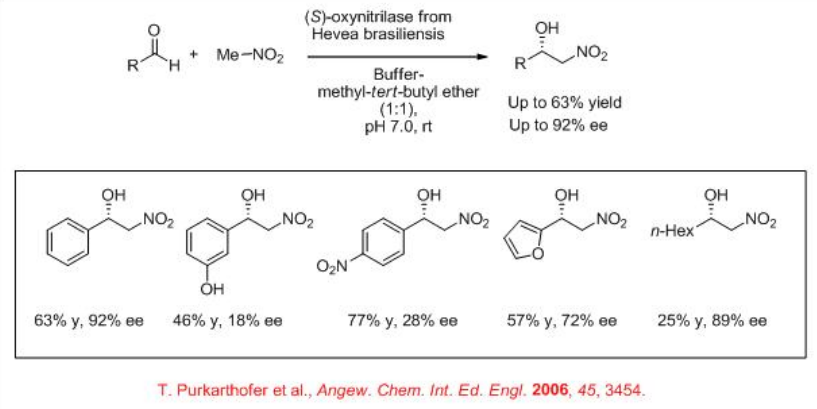11.2: Formación de enlaces carbono-carbono
- Page ID
- 73283
Los biocatalizadores resultan ser catalizadores versátiles para la formación de enlaces carbono-carbono y reacciones de reducción en la síntesis orgánica.
La formación de enlaces carbono-carbono pertenece al corazón de la síntesis orgánica. La ruta biocatalizada proporciona una herramienta efectiva para la construcción de carbono-carbono con excelente enantioselectividad.
Hidrocianación de Aldehídos
La hidrocianación biocatalítica de aldehídos es uno de los métodos más antiguos en síntesis orgánica. Una de las tecnologías bien establecidas para la hidrocianación a gran escala de aldehídos es la producción catalizada por oxinitrilasa (proceso Griengl) de cianohidrinas (S) -fenoxibenzaldehído, que es un intermedio importante para la fabricación industrial de piretroides (Esquema\(\PageIndex{1}\)). Este método resulta útil para las reacciones de numerosos aldehídos.

Condensación Benjuí
El desarrollo de una condensación asimétrica de benzoína cruzada a través de reacciones enzimáticas de acoplamiento cruzado es un proceso sintéticamente útil. Se pueden obtener benzoínas mixtas altamente enriquecidas enantioméricamente a partir de dos benzaldehídos sustituidos diferentes usando benzaldehído liasa como catalizador (Esquema\(\PageIndex{2}\)). Uno de los aldehídos actúa como aceptor, mientras que el otro actúa como donante.

Reacción de Aldol
Las reacciones aldólico biocatalíticas son altamente específicas con respecto al componente donante, mientras que se observa un amplio alcance de sustrato para las moléculas aceptoras. Uno de los ejemplos es la reacción de glicina (donante) con benzaldehído sustituido (aceptor) empleando treonina aldolasas para dar α-amino β -hidroxiácidos con excelente enantioselectividad (Esquema\(\PageIndex{3}\)).

Reacción nitroaldol
Las enzimas también son útiles para las reacciones no naturales. Por ejemplo, usando (S) -oxinitrilasa se puede lograr la reacción de nitrometano con una amplia gama de aldehídos con excelente enantioselectividad (Esquema\(\PageIndex{4}\)). El nitroalcano actúa como donante, mientras que los aldehídos son aceptores.



